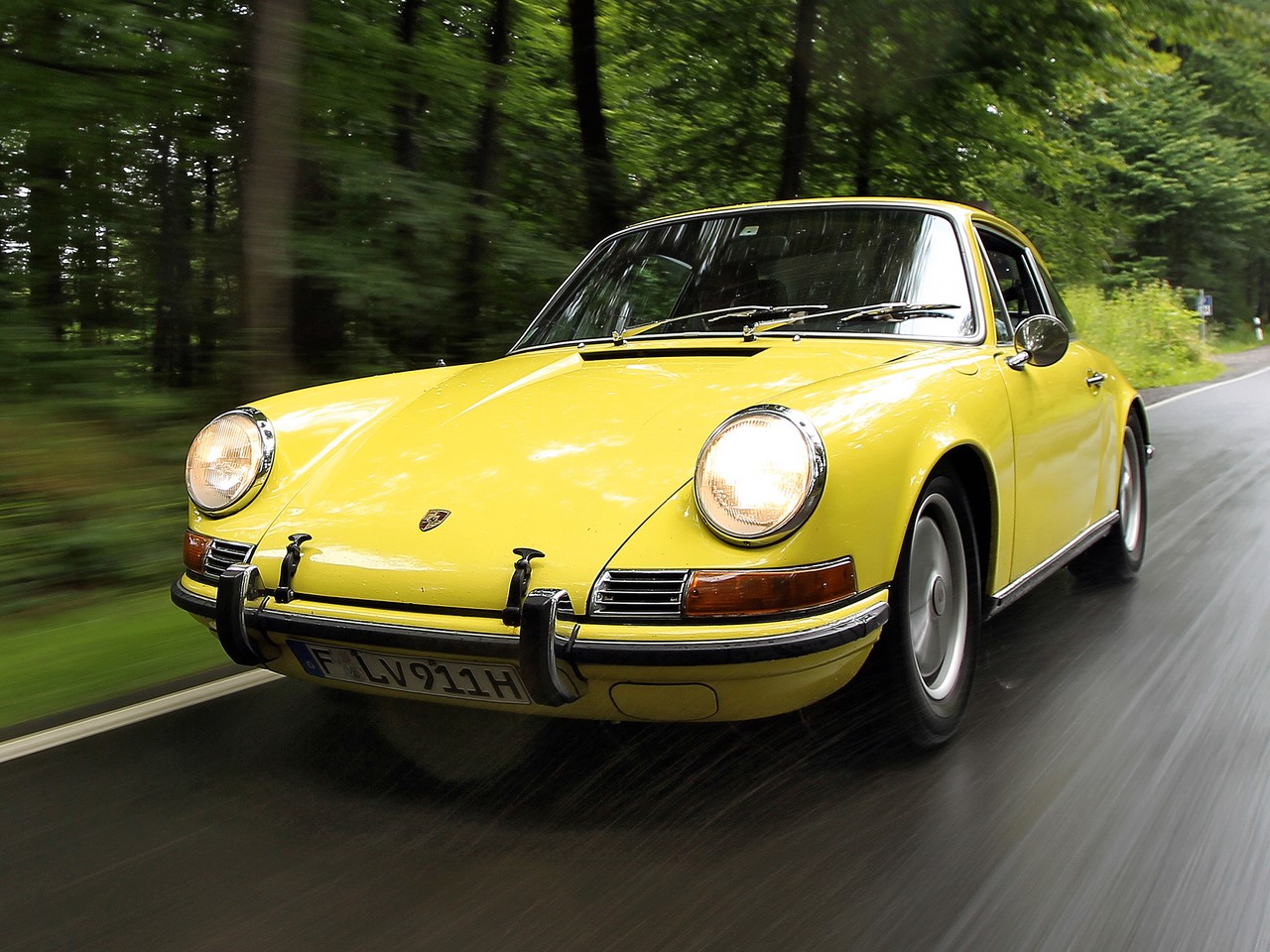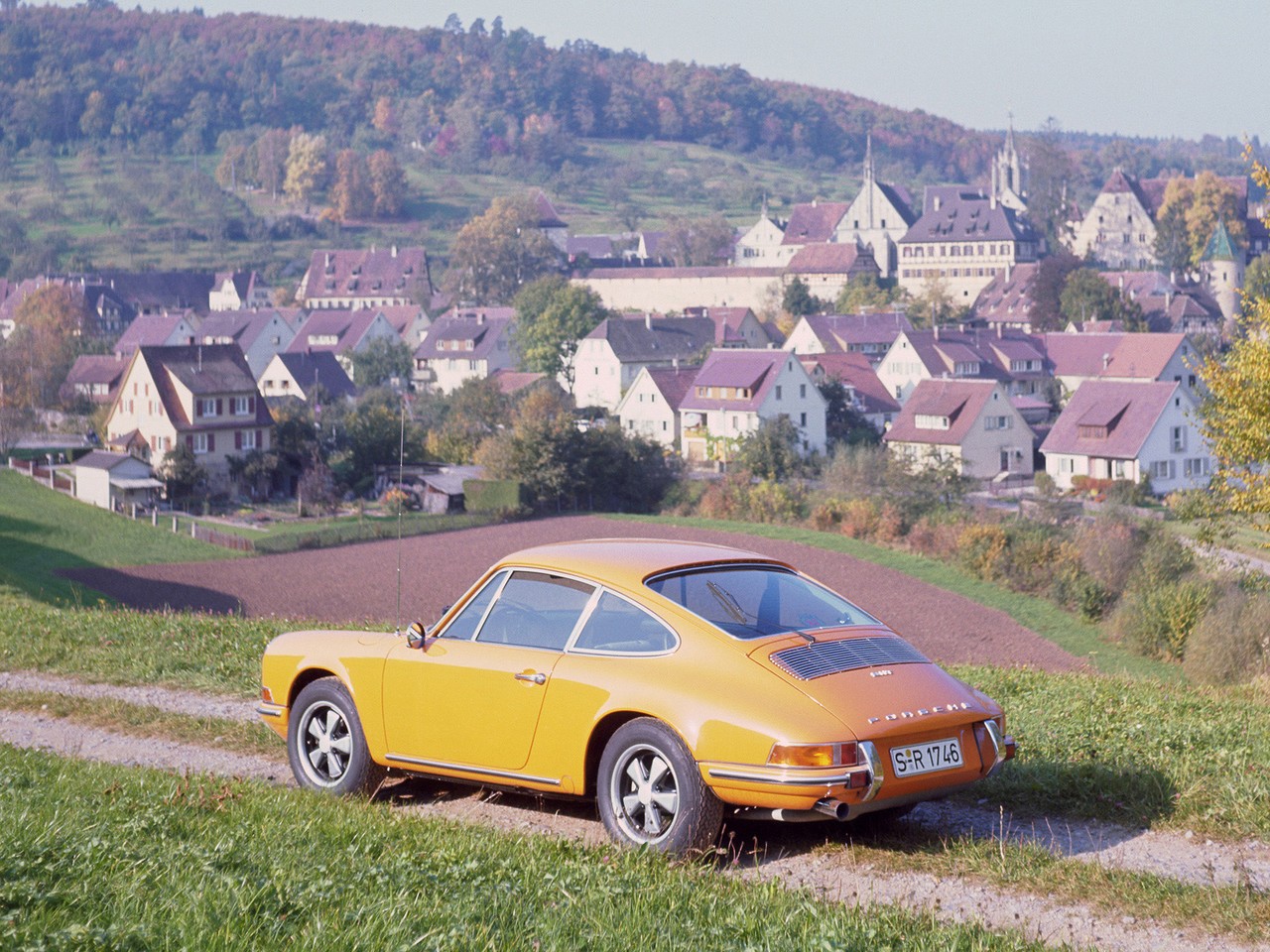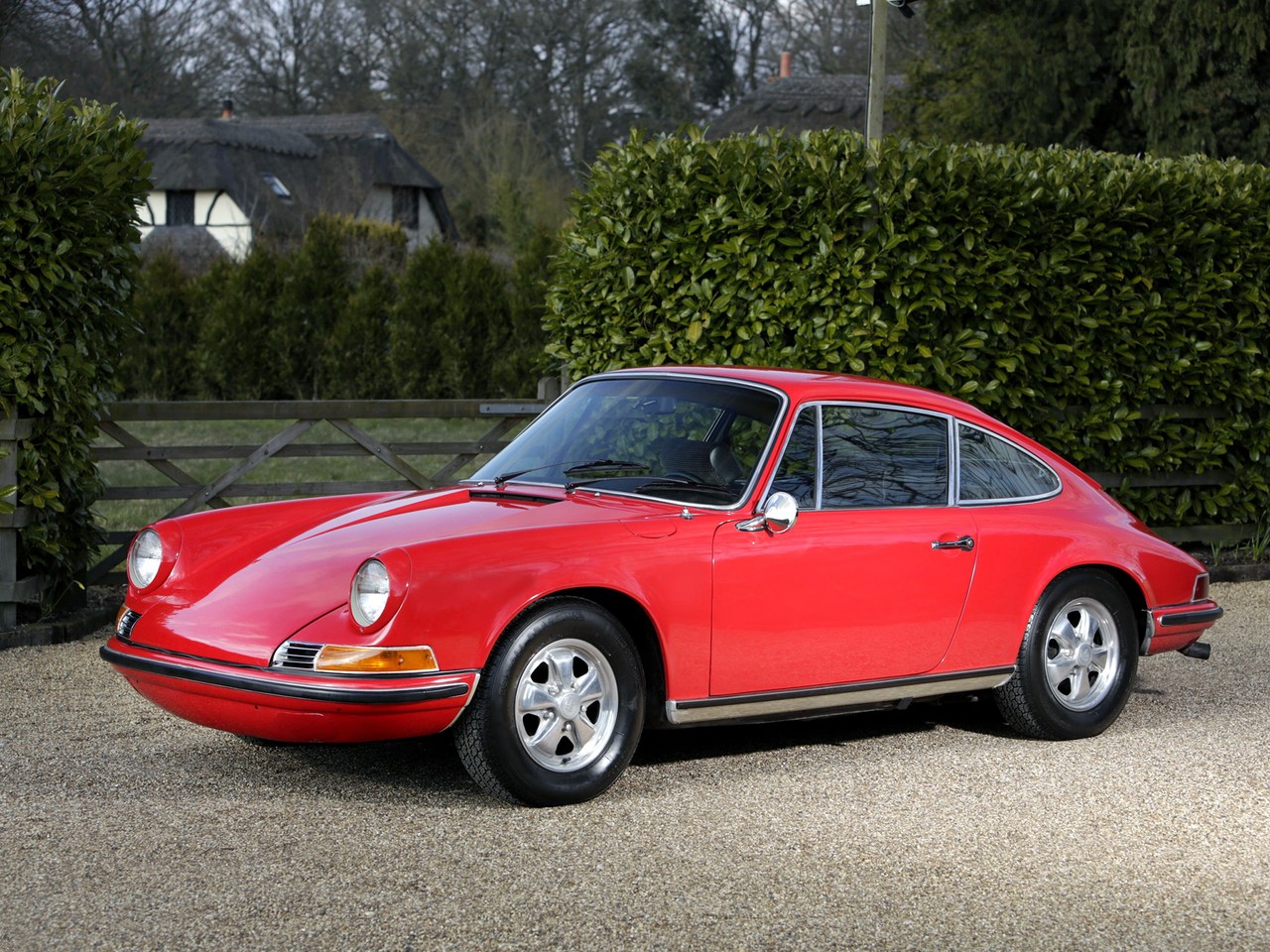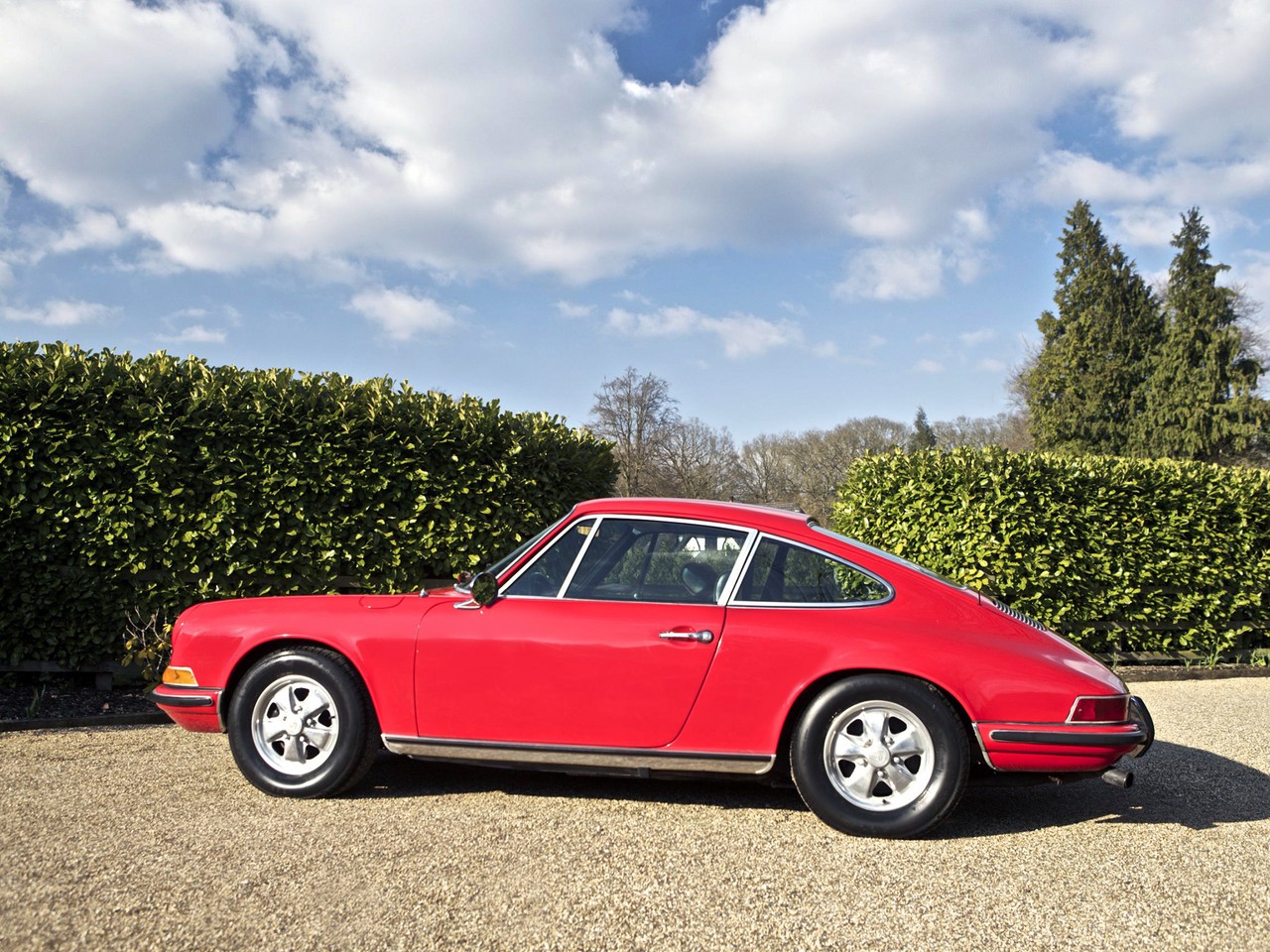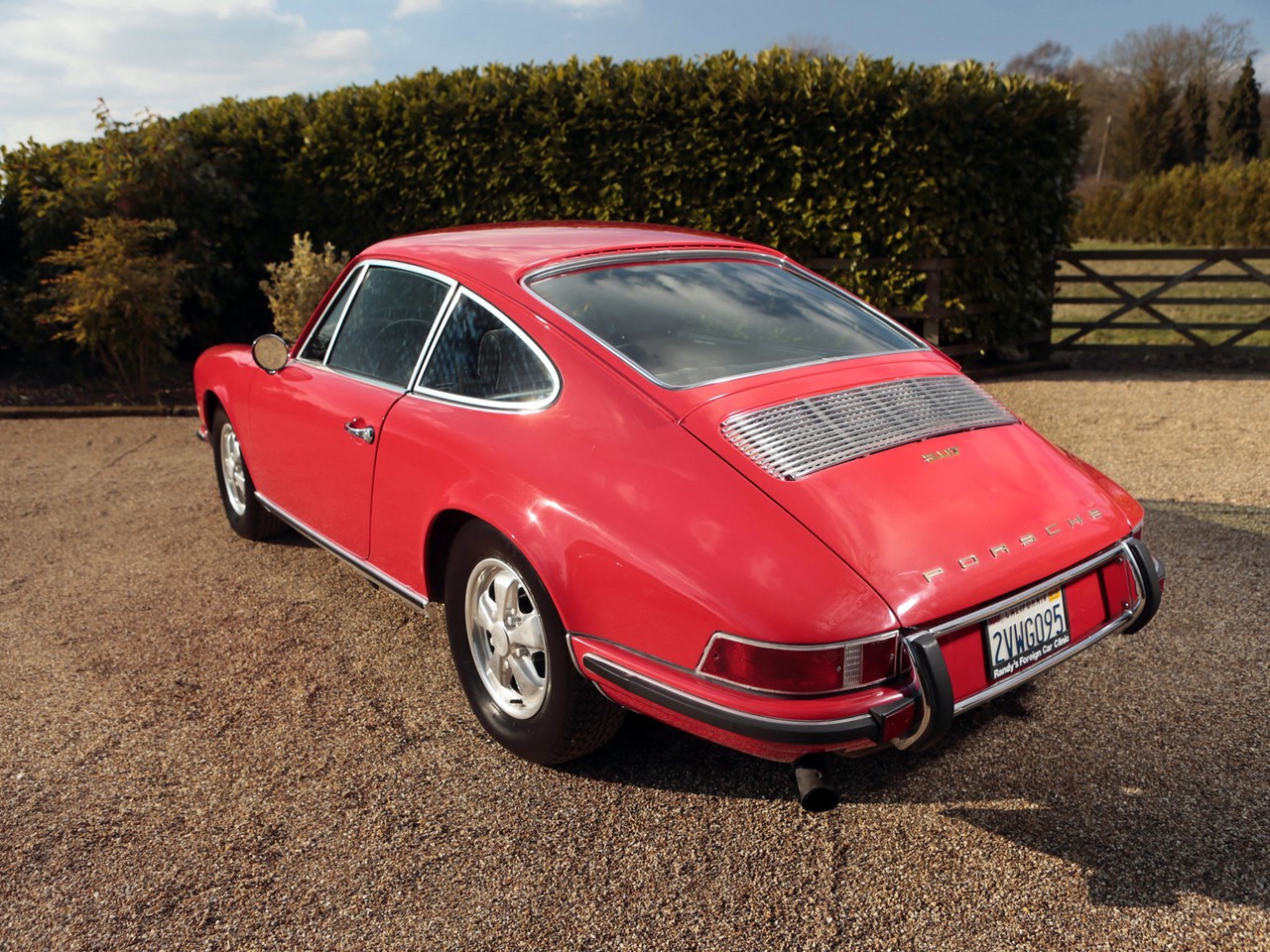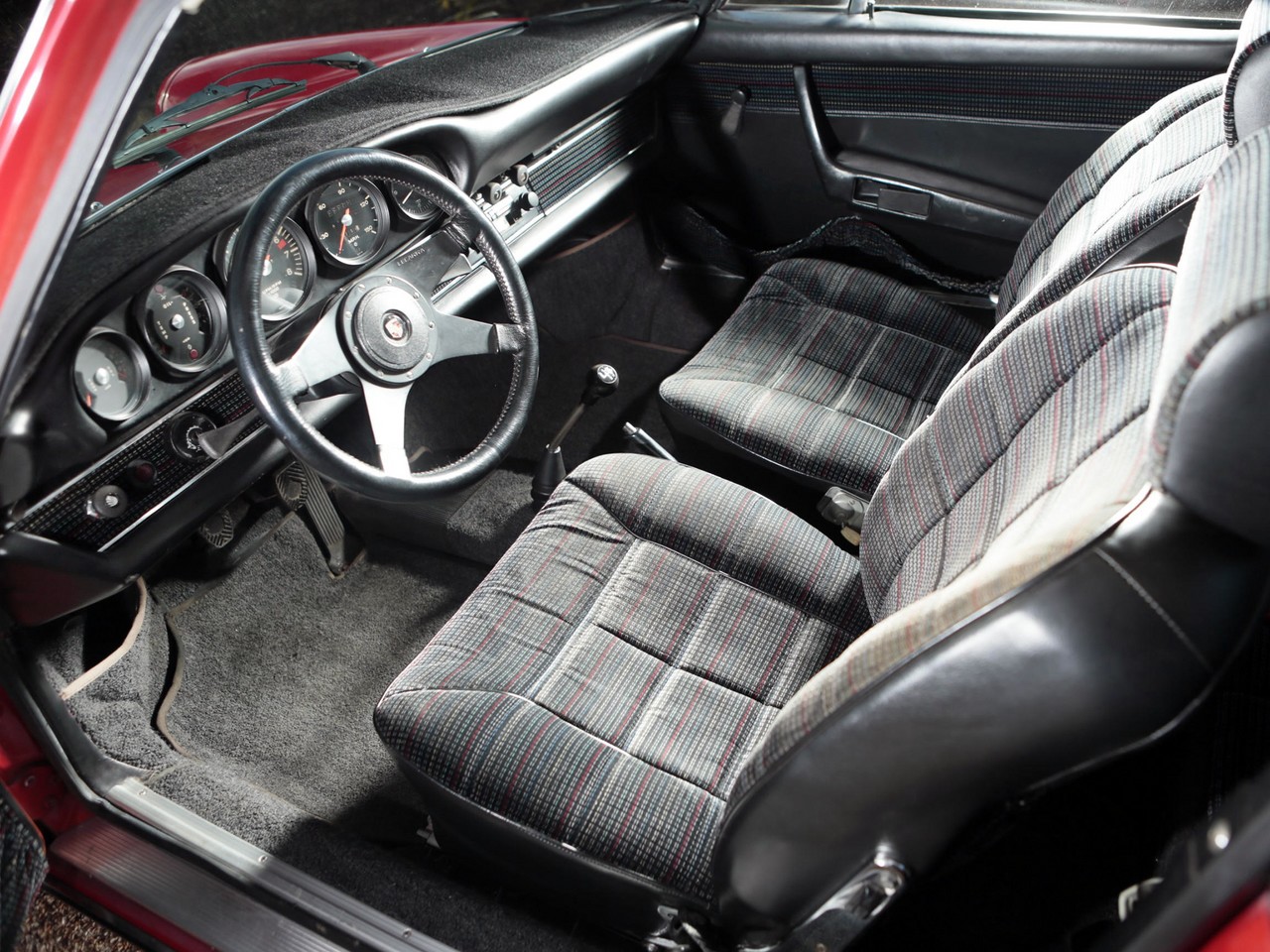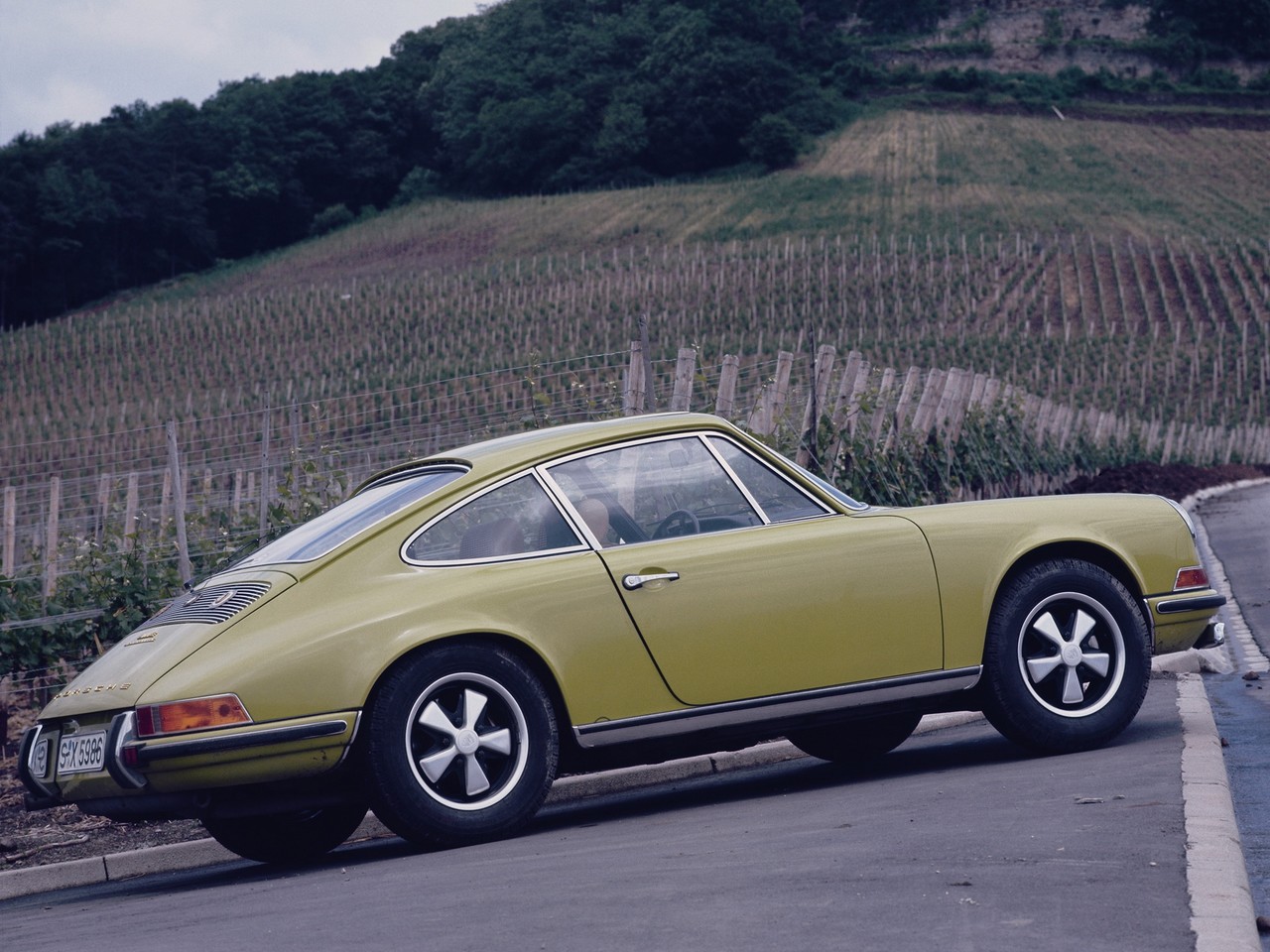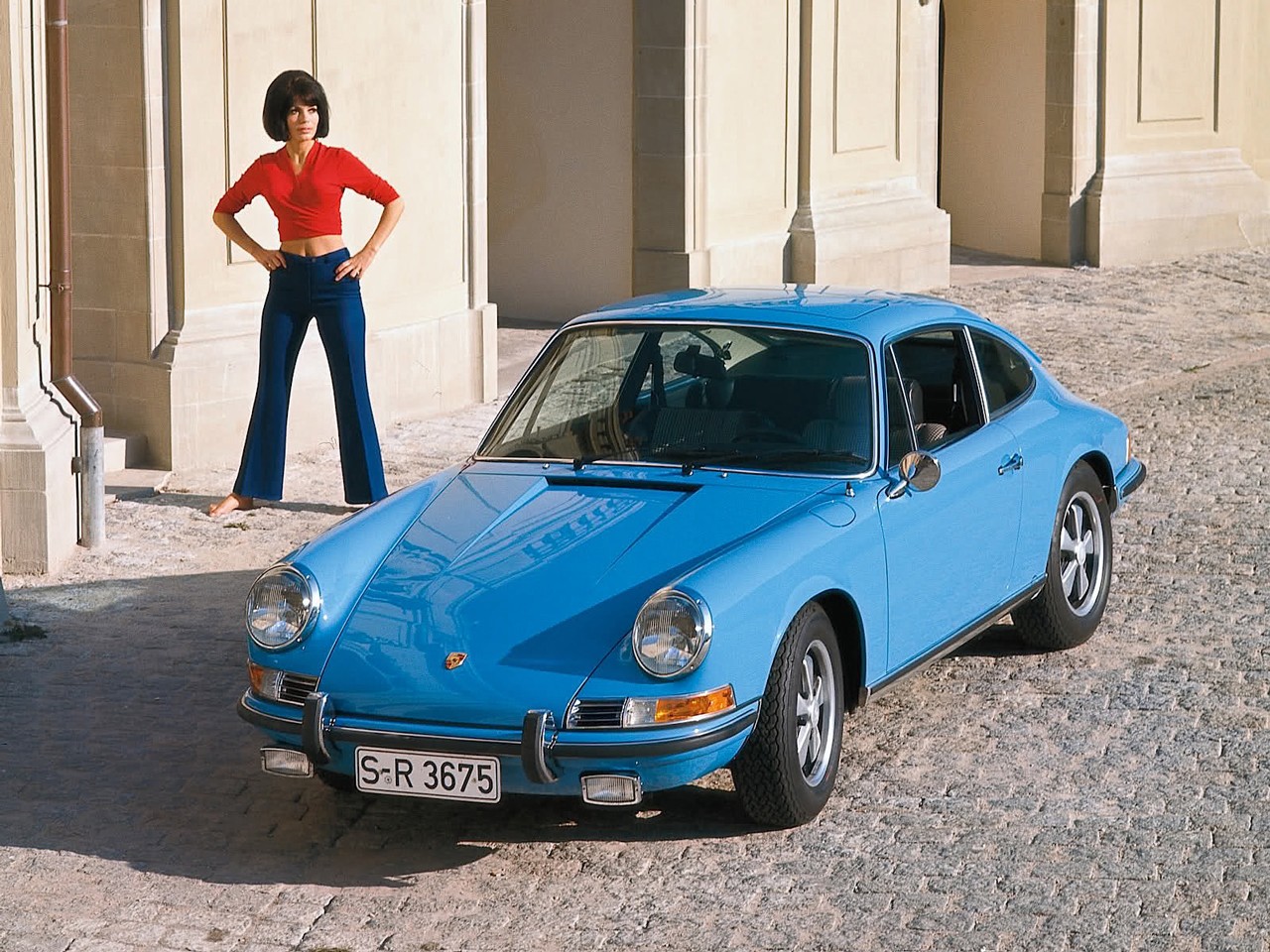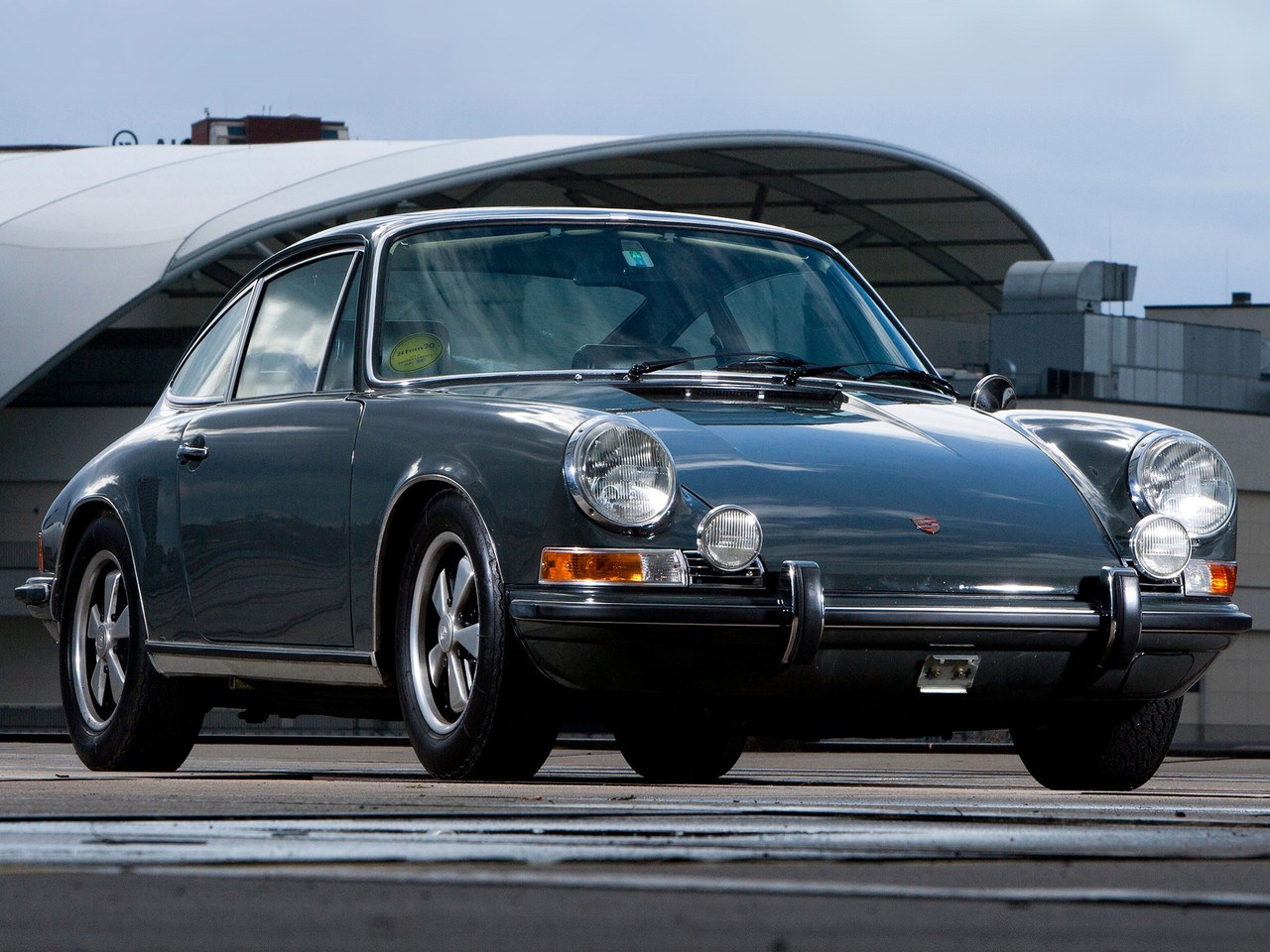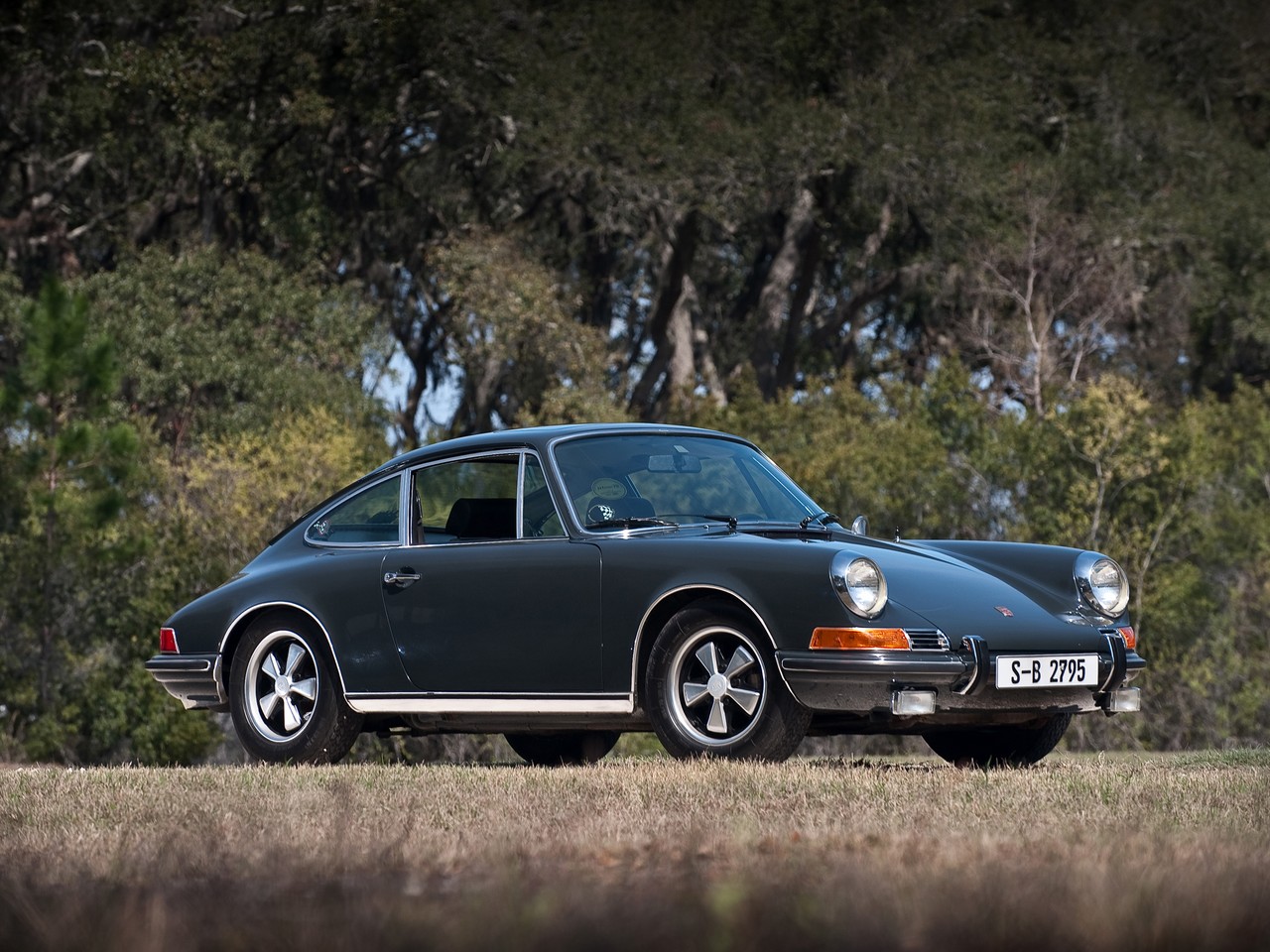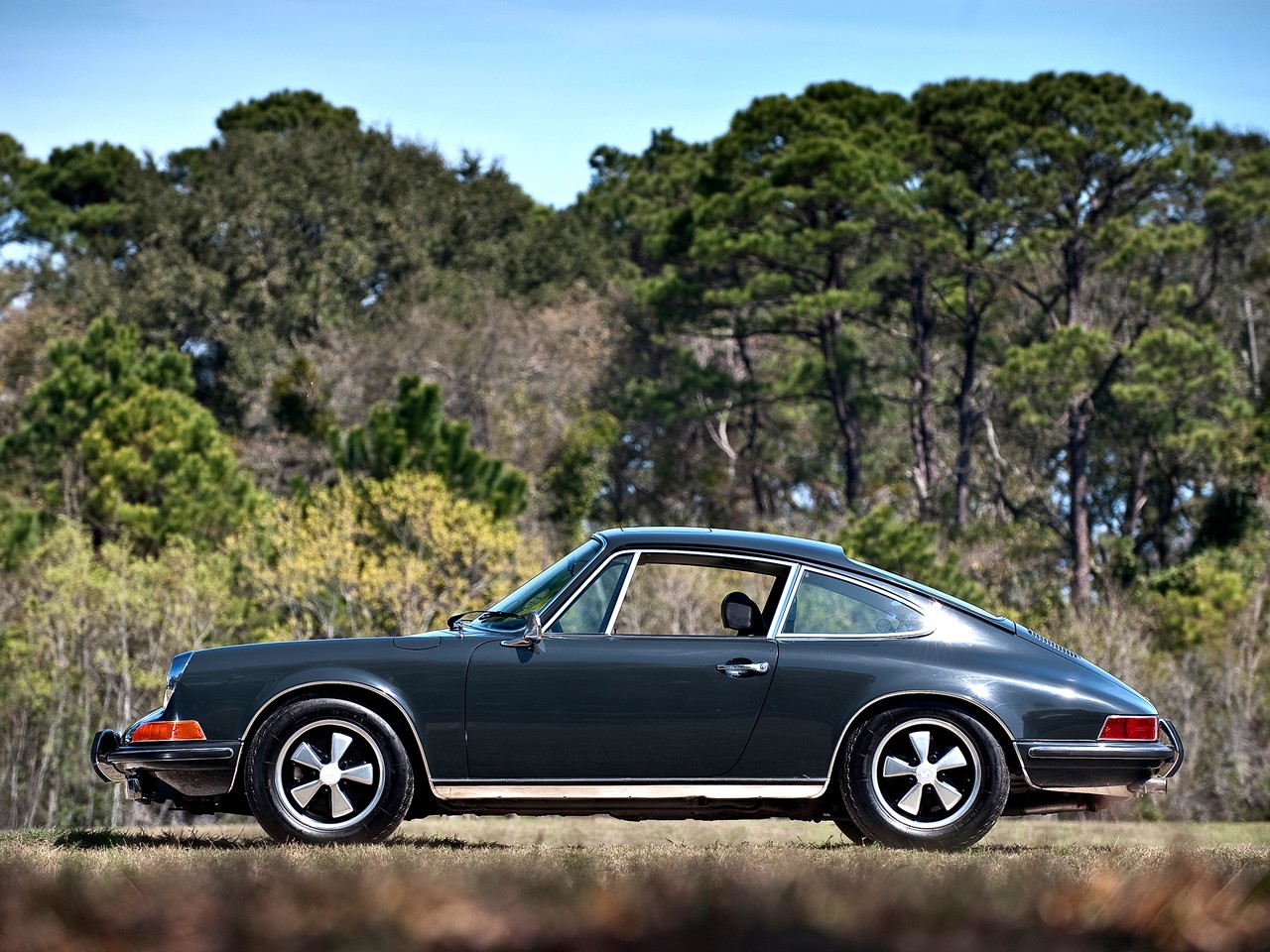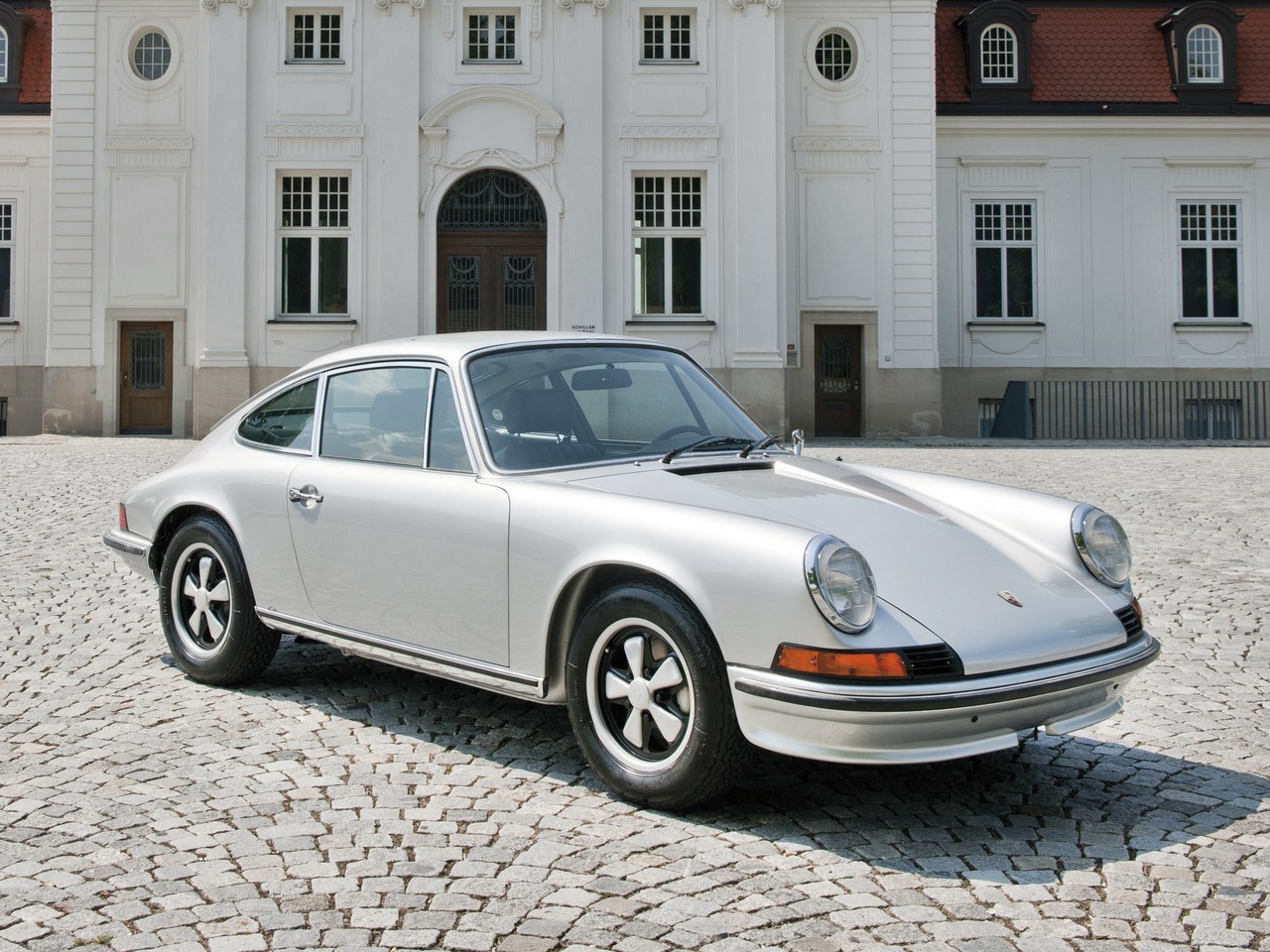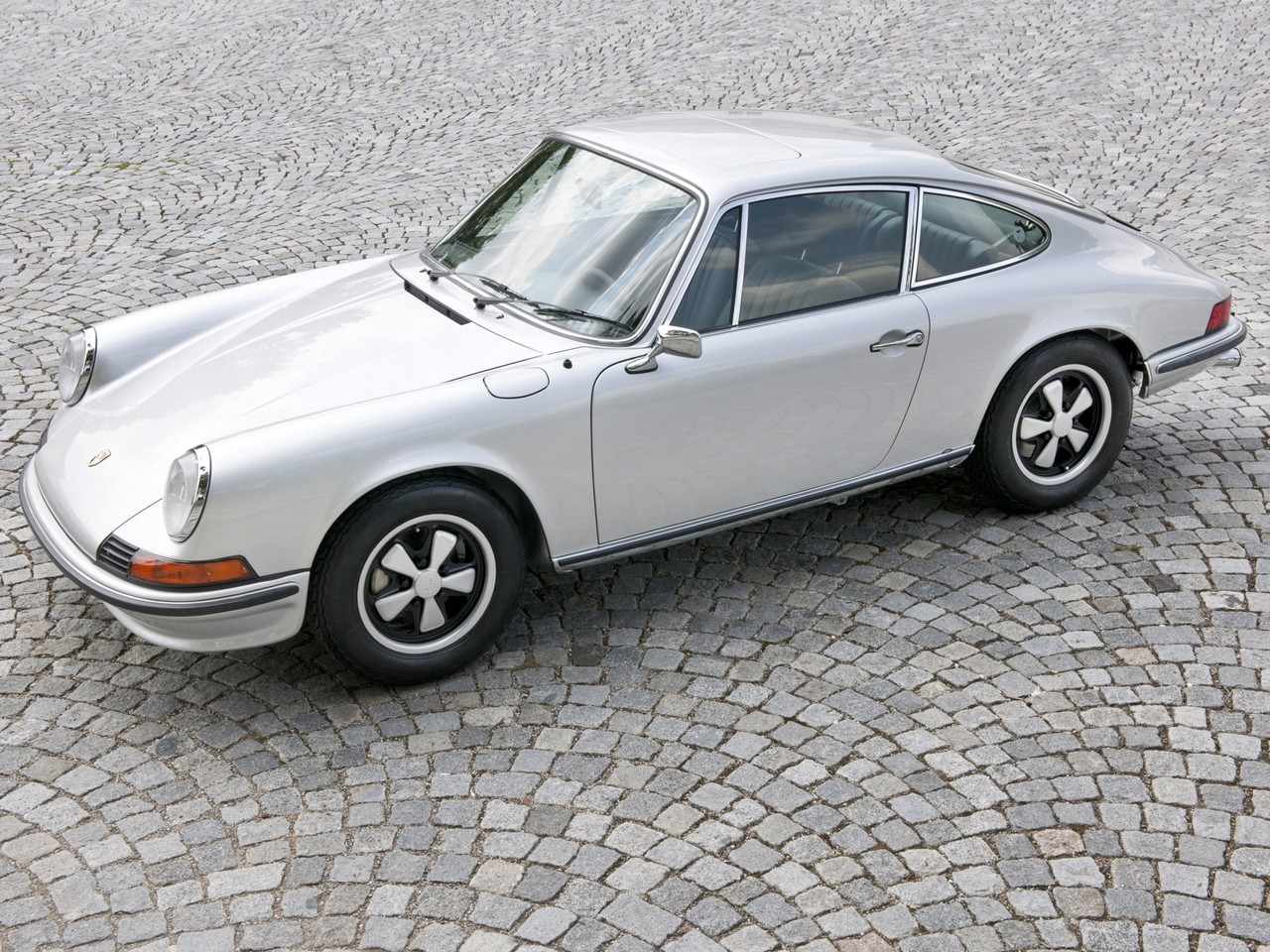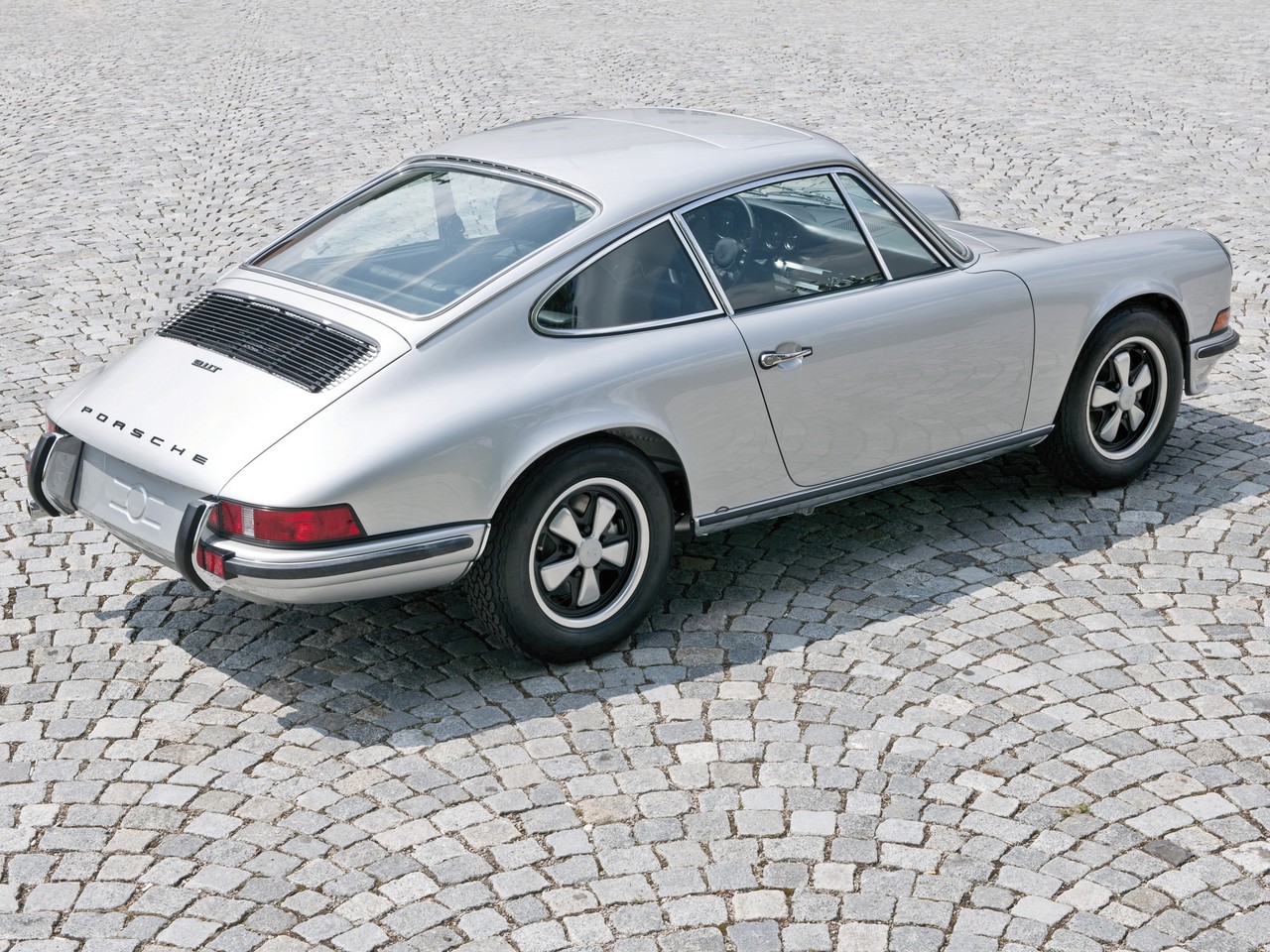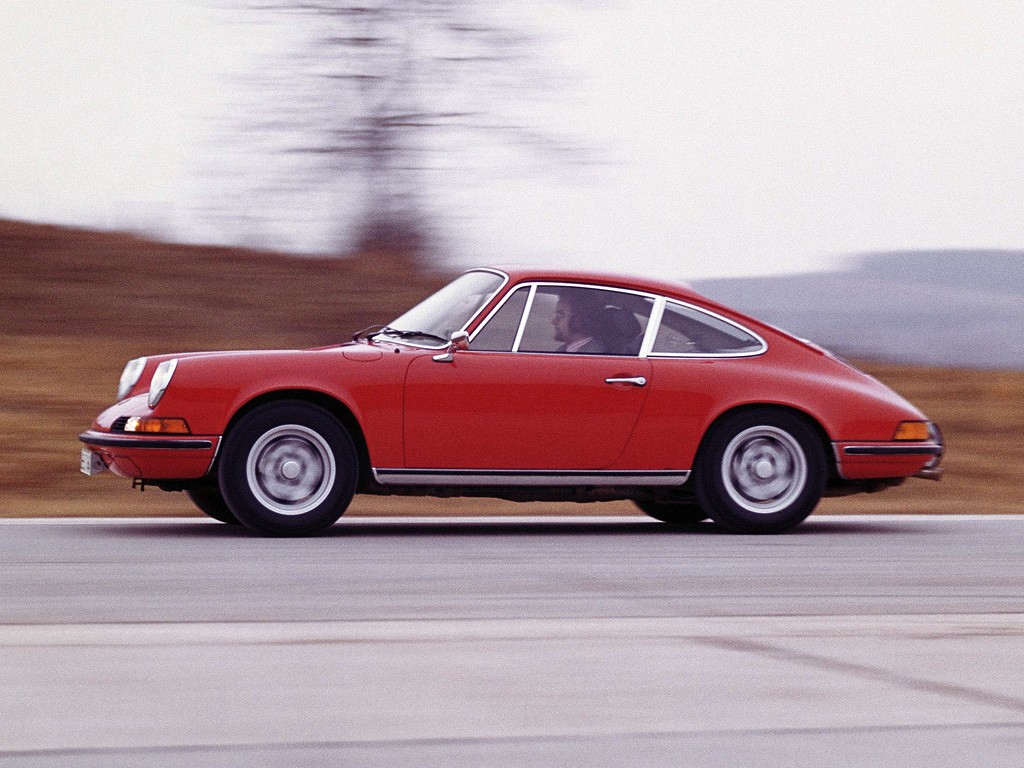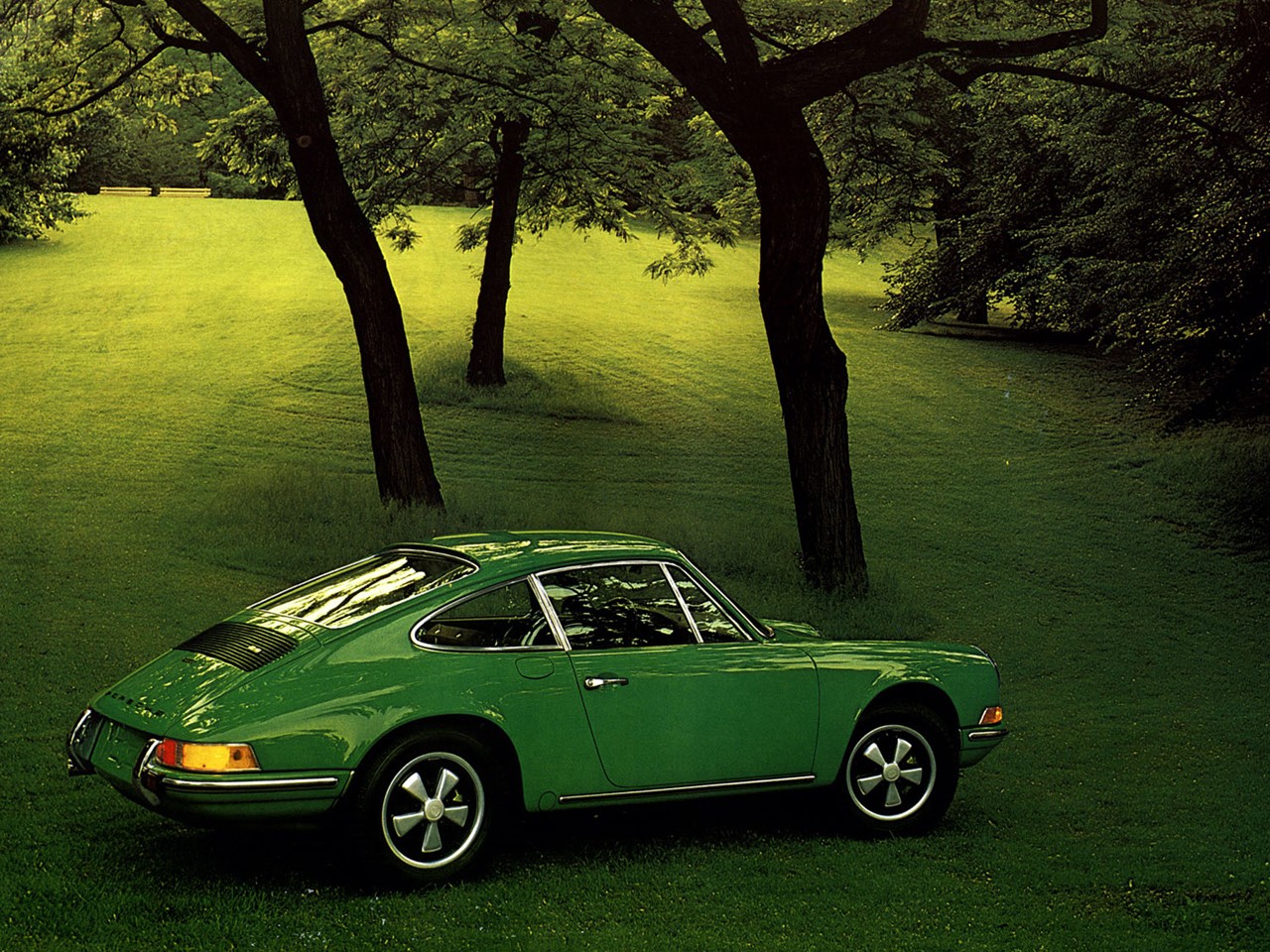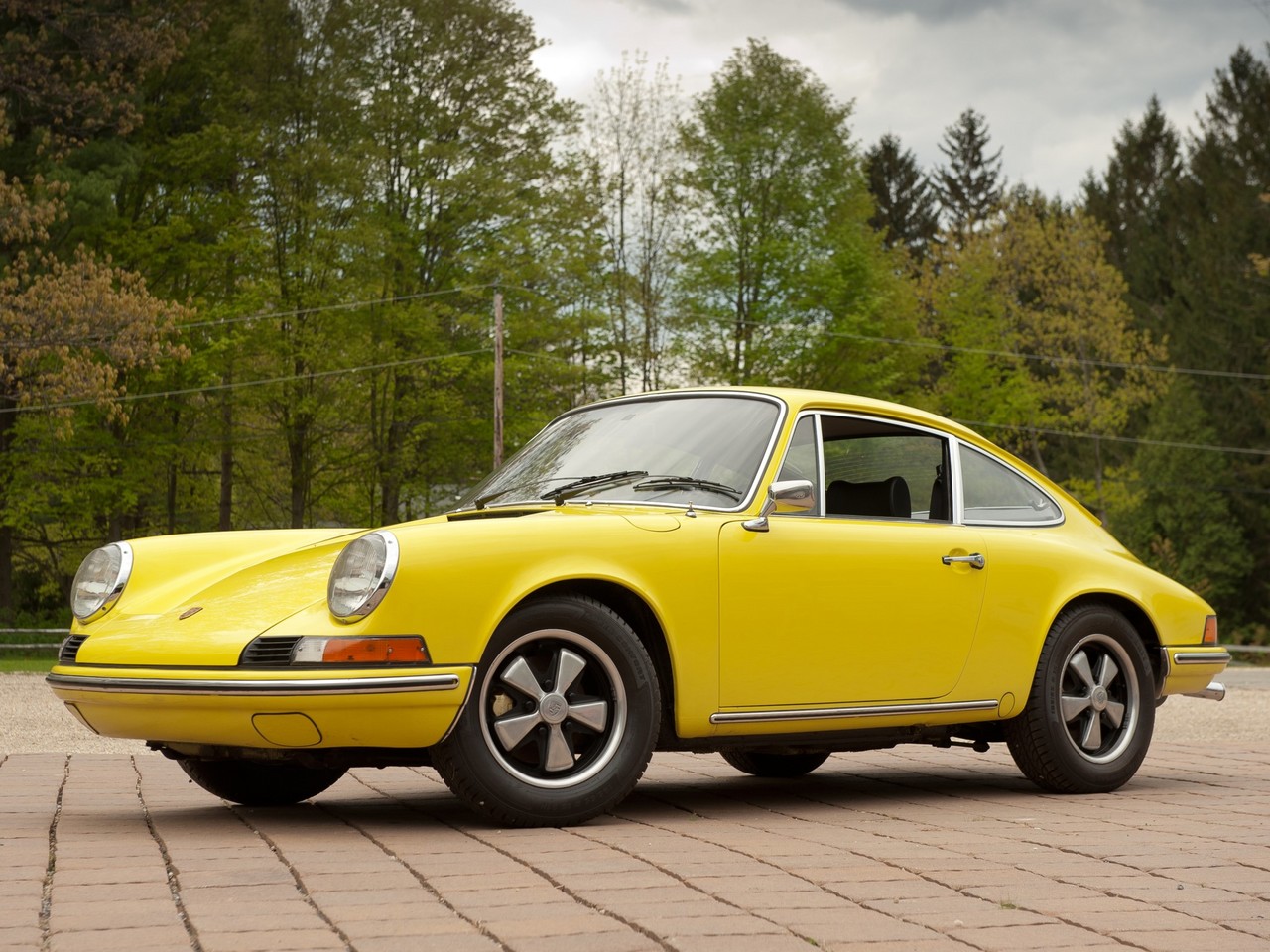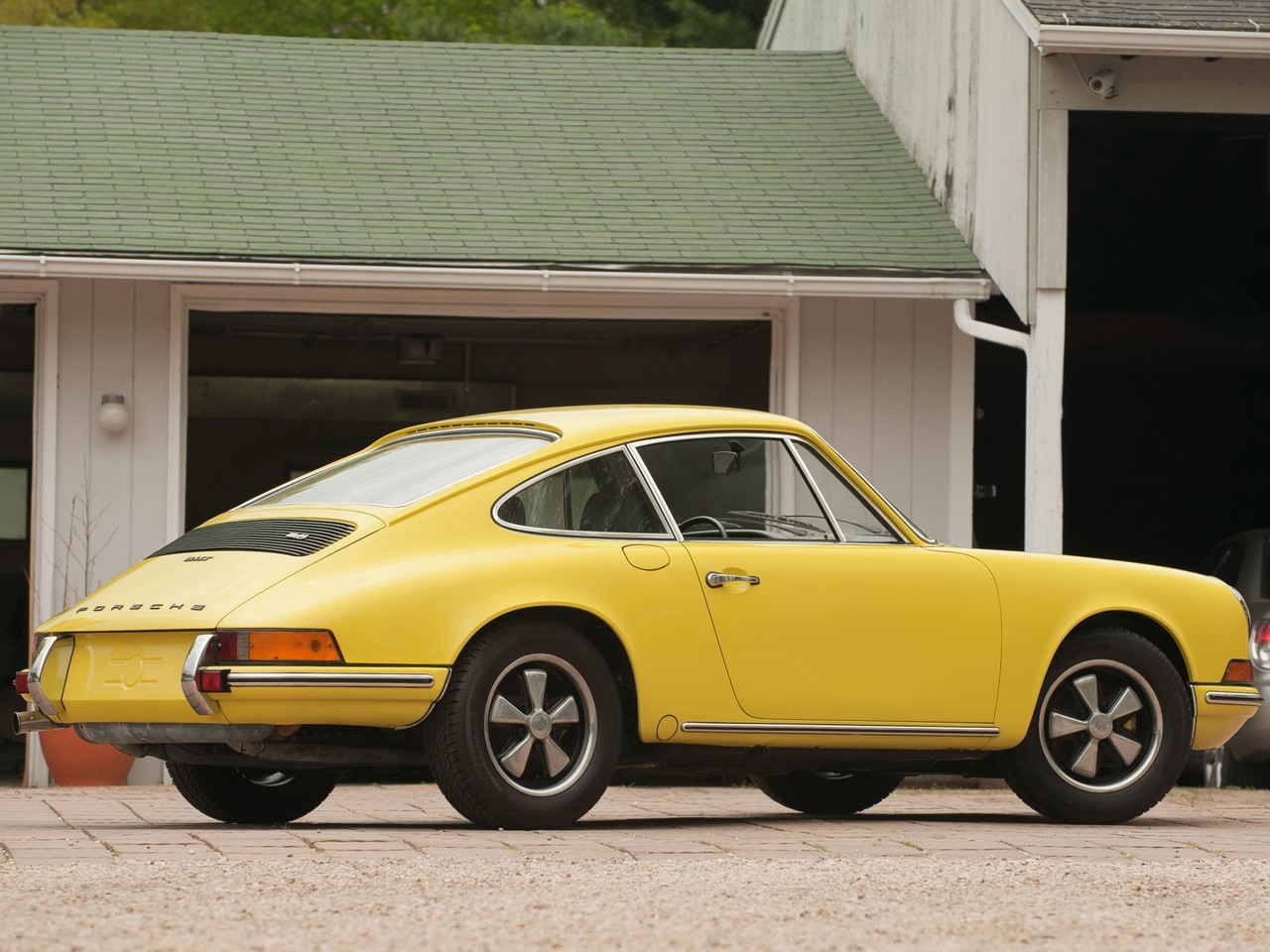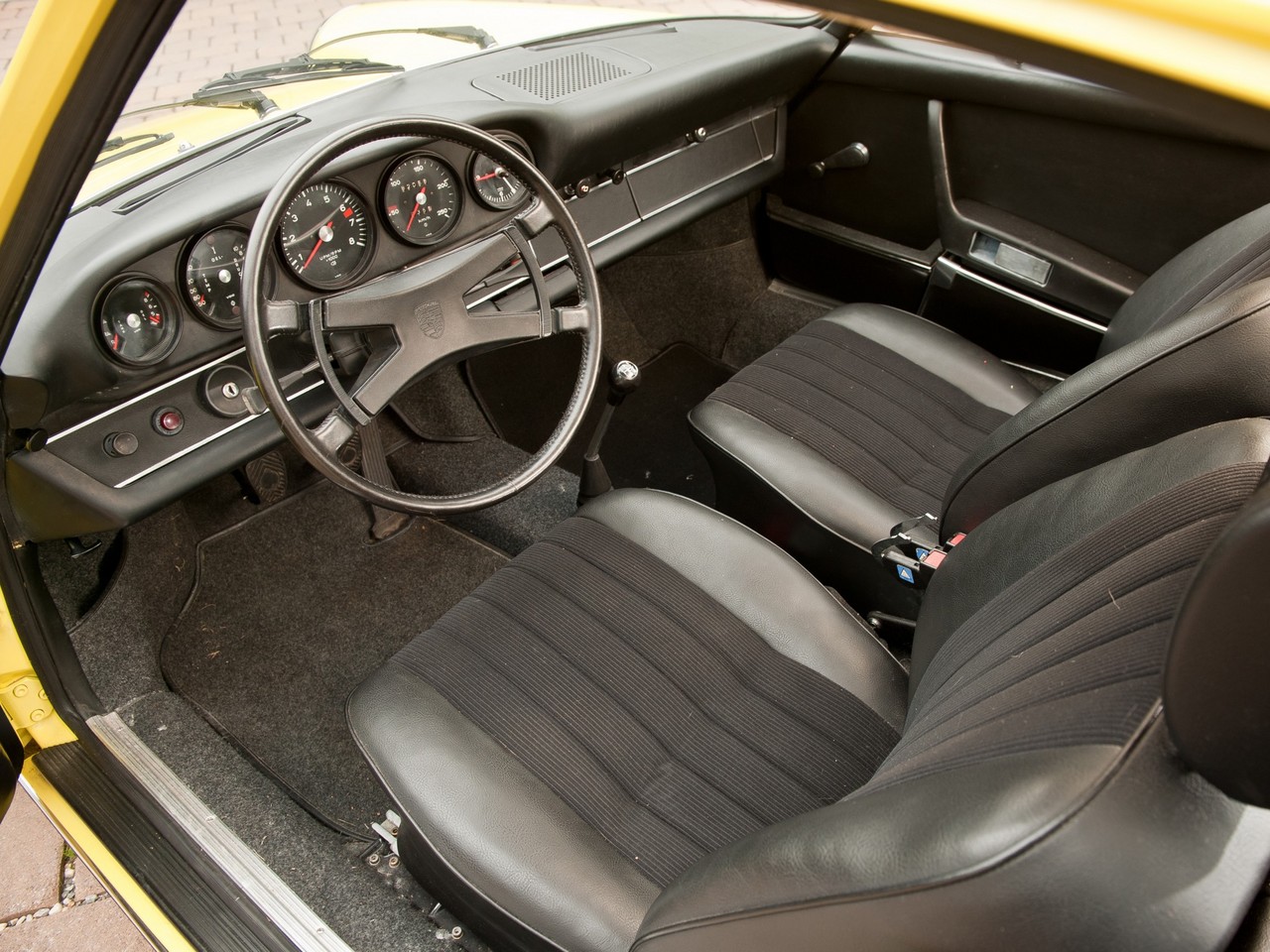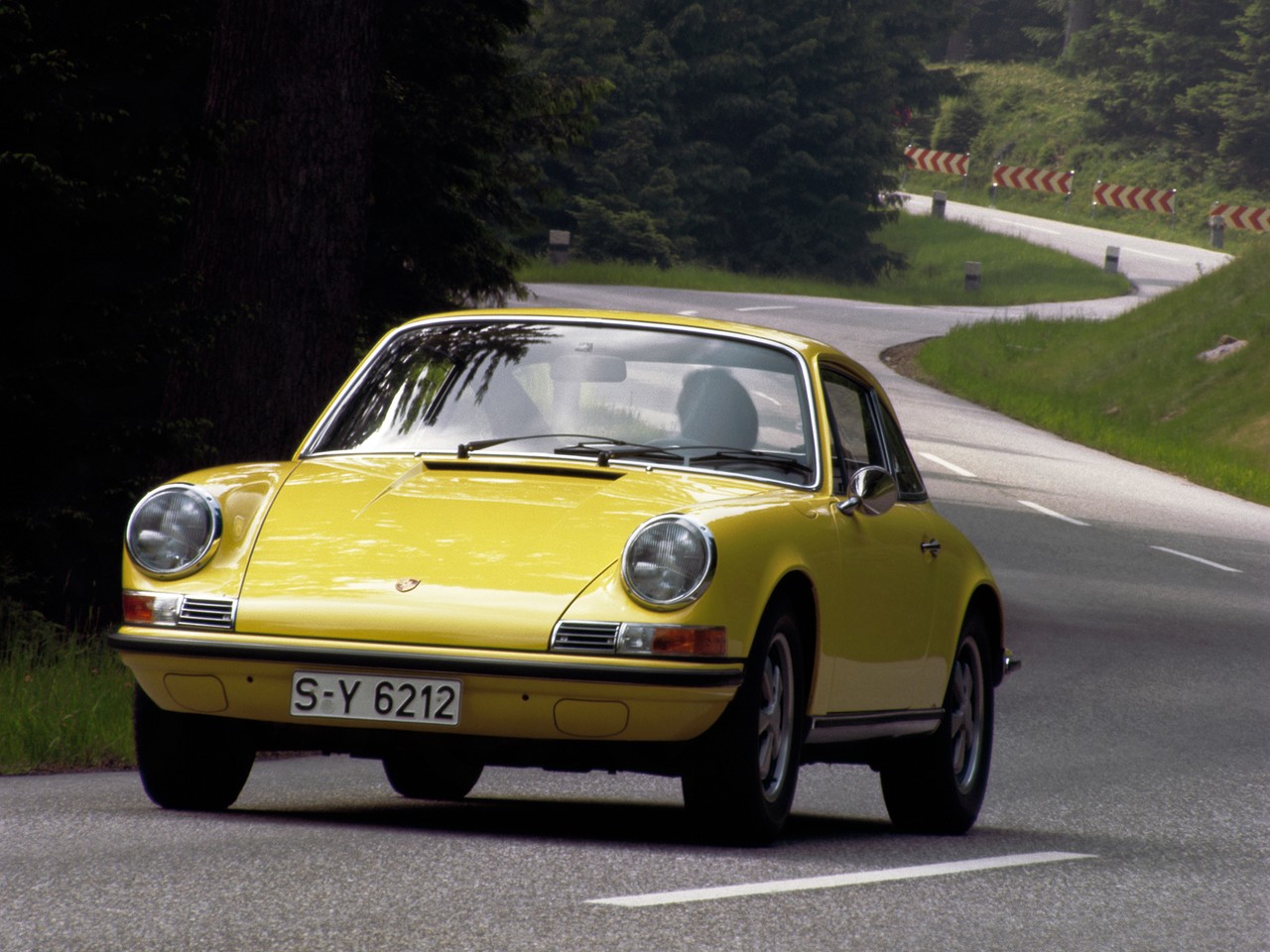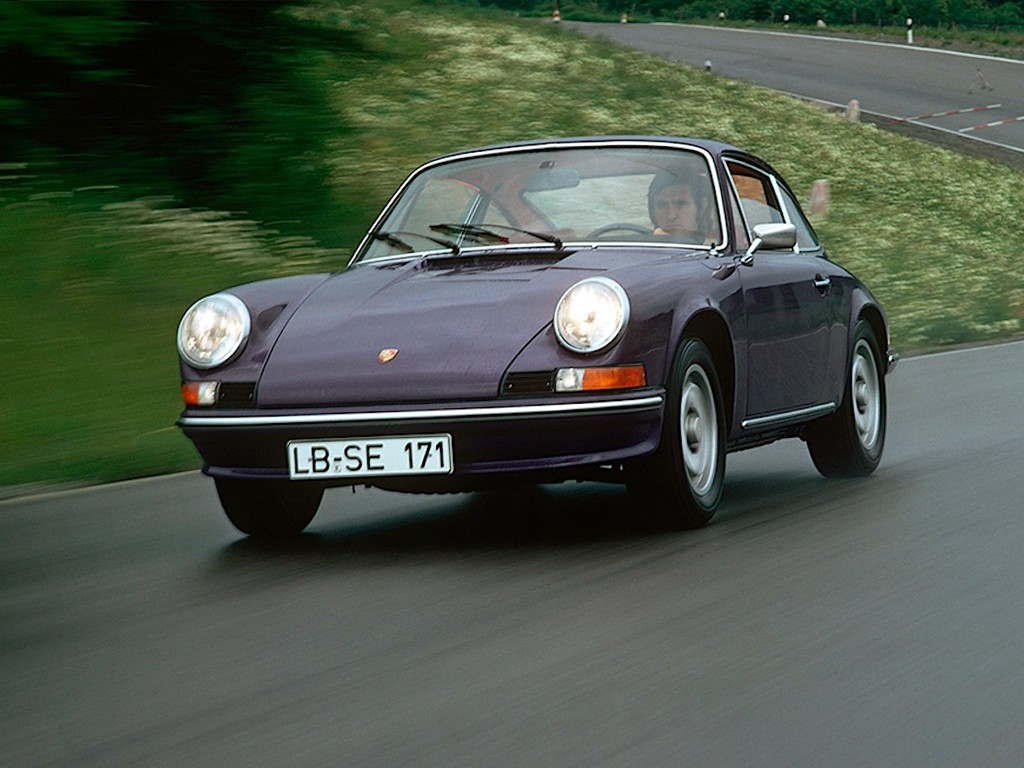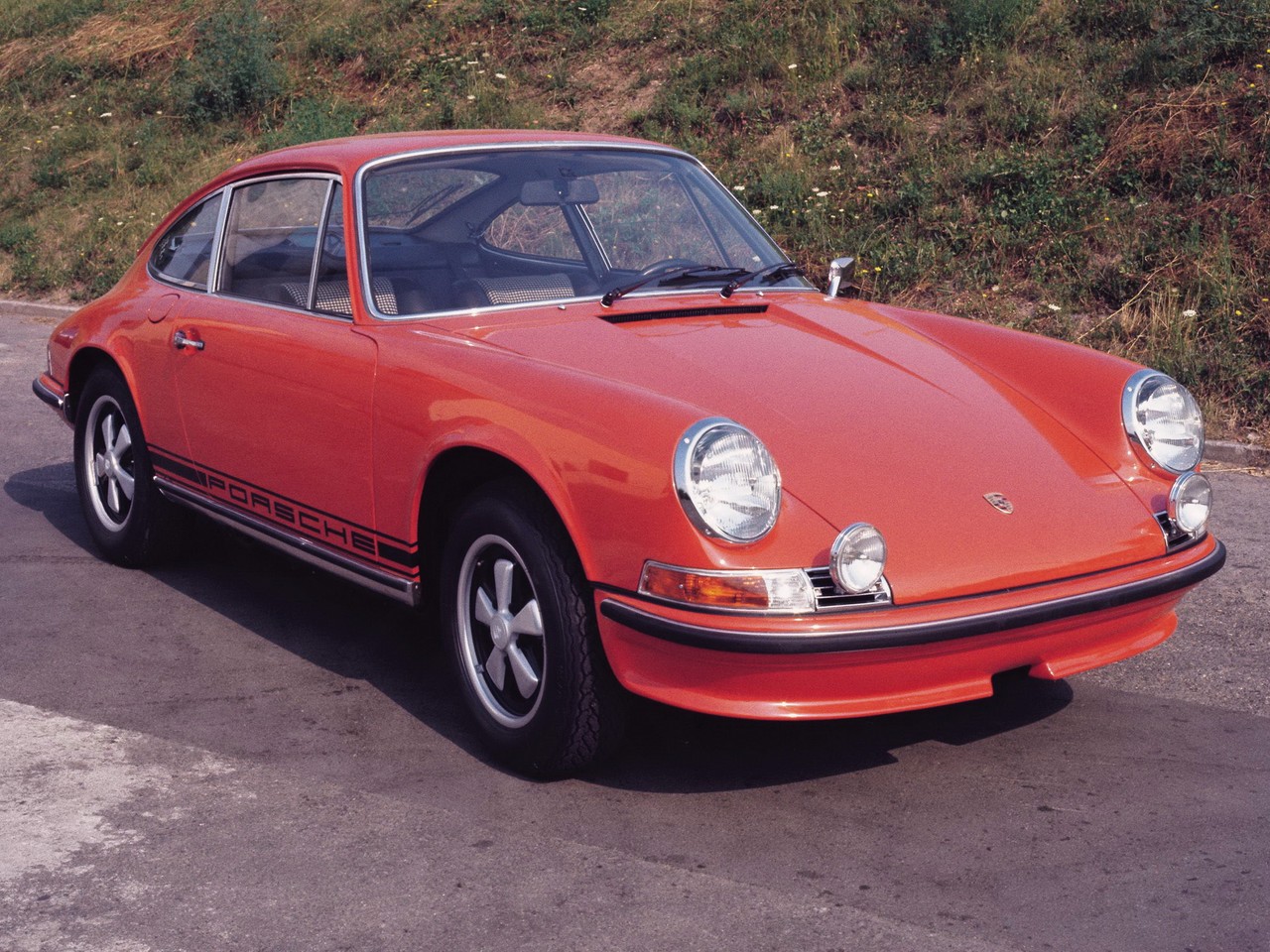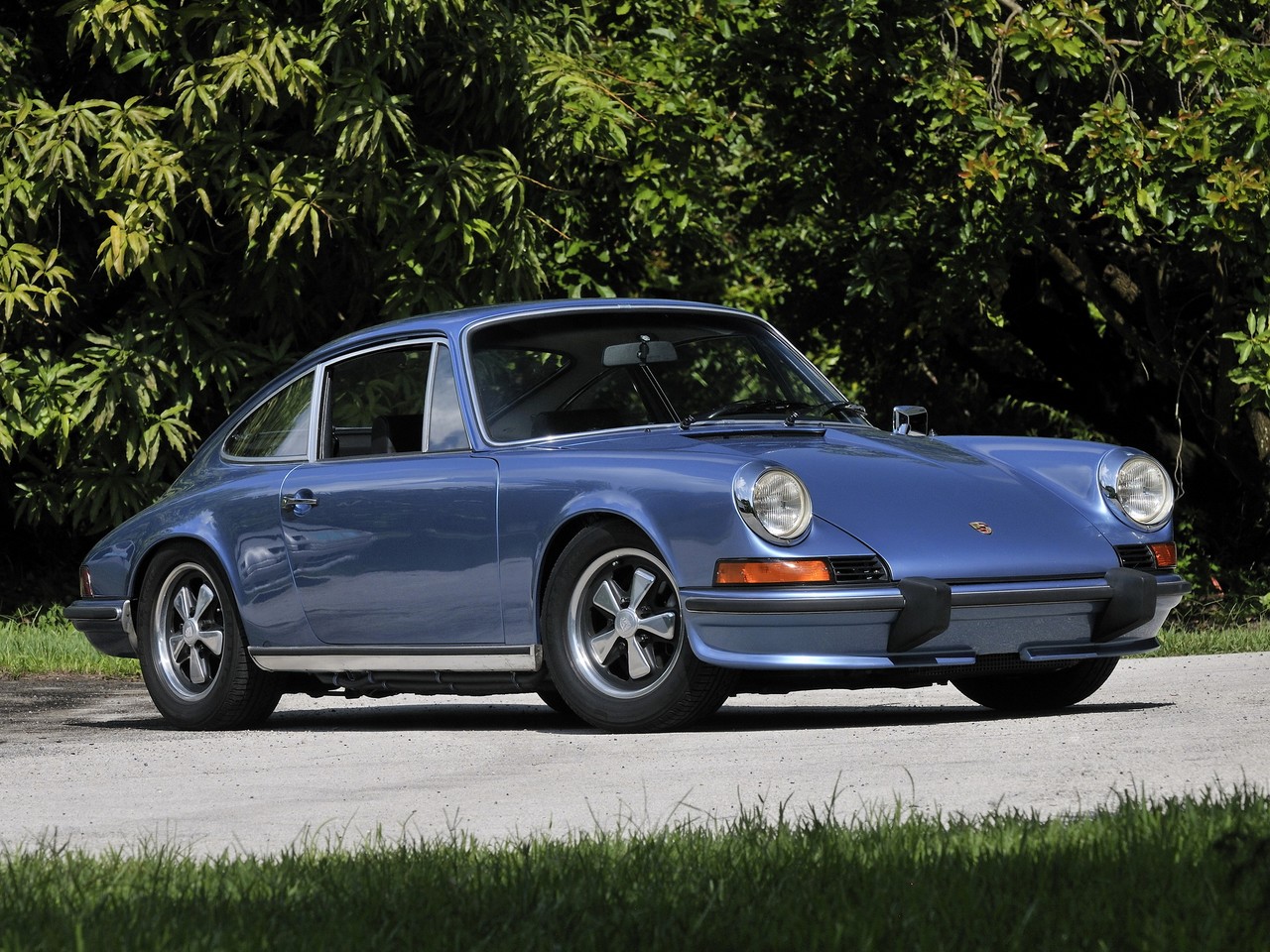
- Flat torque curve for 911 T
- Responsive engine for 911 E
- Effective brakes
- Light steering is accurate
- An iconic, collectible sports car
- Unforgiving dynamics: steady-state understeer, transient oversteer and bump steer
- Lift-off oversteer
- Engine for 911 S has top-end performance but is lacking elsewhere
- For manual transmission, shifter has rubbery feel
- Chain tensioner failure can destroy the engine. Owners should consider fitting mechanical tensioner guards
Review: Porsche C- and D-Series 911 Coupe (1969-71)
Overview
Production of the Porsche C-Series 911 Coupe commenced in August 1969 at Porsche’s Zuffenhausen factory in Stuttgart, Germany. Compared to its B-Series predecessor, the C-Series 911 introduced a 2.2-litre horizontally-opposed (or flat) six-cylinder engine which had better low-end power and a broader torque curve. Like its B-Series predecessor, however, the C- and D-Series 911 Coupe range consisted of T, E and S variants (see table below).
Engines
Compared to its 2.0-litre predecessor, the 2.2-litre engine continued to have an alloy cylinder block and head, two valves per cylinder and an overhead camshaft per cylinder bank. The increase in displacement was achieved by extending the bore from 80.0 mm to 84.0 mm (stroke was unchanged at 66.0 mm), while standardized valve sizes were also introduced (46 mm for intake valves and 40 mm for exhaust valves). Of the engines,
- The 911 T engine had Zenith 40 TIN carburetors (previously Weber 40 IDT P) and a compression ratio of 8.6:1;
- The 911 E engine had Bosch mechanical fuel injection and a compression ratio of 9.1:1; and,
- The 911 S engine also had mechanical fuel injection, but was distinguished by its more aggressive camshaft profile, almost 10 per cent larger intake and exhaust ports, higher compression pistons and compression ratio of 9.8:1.
Dimensions and suspension
The C- and D-Series 911 Coupe was 4163 mm long, 1610 mm wide, 1320 mm tall and had a 2268 mm long wheelbase. Furthermore, the 911 had independent front suspension with longitudinal torsion bars and lower transverse arms, while the independent rear suspension had semi-trailing arms and transverse torsion-bar springs.
August 1970: D-Series 911
Production of the D-Series 911 commenced in August 1970. Changes, however, were limited to nozzles that were fabricated into the engine case cross-members which sprayed oil onto the bottom of the pistons to reduce temperatures and prolong engine life.
| Engine | Trans. | Years | Peak power | Peak torque | |
|---|---|---|---|---|---|
| 911 T | 2.2-litre F6 | 4sp man., 5sp man., 4sp semi-auto |
1969-71 | 92 kW at 5800 rpm | 176 Nm at 4200 rpm |
| 911 E | 2.2-litre F6 (FI) | 5sp man., 4sp semi-auto |
1969-71 | 114 kW at 6200 rpm | 191 Nm at 4500 rpm |
| 911 S | 2.2-litre F6 (FI) | 5sp man. | 1969-71 | 132 kW at 6500 rpm | 199 Nm at 5200 rpm |
911 T
The C- and D-Series 911 T was fitted with ventilated disc brakes (previously limited to the 911 E and 911 S) and a five-speed manual transmission was available as an option.
911 E
Positioned as the Luxury variant within the range, the 911 E had a unique front suspension arrangement whereby the front torsion bar was replaced with Boge hydro-pneumatic gas and oil filled struts.
911 S
To reduce weight, the rear deck and centre bumper panel for the C- and D-Series 911 S were made from aluminium. Likes its B-Series predecessor, the 911 S continued to be fitted with aluminium Ate front brake calipers and have an oil cooler in its right front fender.
Limited slip differential
Both the C- and D-Series 911 models were offered with an optional ZF multi-disc limited slip differential which, in adverse conditions, would operate to transfer power away from the slipping tyre to the wheel with the traction.
Related links
Review: Porsche E- and F-Series 911 Coupe (1971-73)
Overview
Produced from August 1971, the E-Series 911 introduced a 2341 cc engine as its stroke was extended from 66.0 mm to 70.4 mm. Due to air pollution and low-octane fuel requirements, compression ratios were lowered to 7.5:1 for the 911 T, 8.0:1 for the 911 E and 8.5:1 for the 911 S. Although fuel injection was introduced for the 911 T in other markets, it is understood that Australian-delivered 911 T vehicles continued to have carbureted fuel delivery.
The E-Series 911 Coupe was fitted with a new five-speed 915 manual transmission which had a conventional H-I gearshift pattern rather than the racing-style shift pattern of its predecessors. Wheelbase length was also extended by 3 mm to 2271 mm.
Compared to its D-Series predecessor, the E-Series 911 could be identified by its repositioned oil tank which had an oblong hatch behind the passenger door. For the F-Series 911 (produced from August 1972), however, the oil tank was returned to its original position in the engine bay to avoid confusion with the fuel tank.
| Engine | Trans. | Years | Peak power | Peak torque | |
|---|---|---|---|---|---|
| 911 T | 2.3-litre F6 | 4sp man., 5sp man., 4sp semi-auto |
1971-73 | 96 kW at 5600 rpm | 196 Nm at 4000 rpm |
| 911 E | 2.3-litre F6 | 5sp man., 4sp semi-auto |
1971-73 | 121 kW at 6200 rpm | 206 Nm at 4500 rpm |
| 911 S | 2.3-litre F6 | 5sp man. | 1971-73 | 140 kW at 6500 rpm | 216 Nm at 5200 rpm |
| 911 Carrera RS | 2.7-litre F6 | 5sp man. | 1972-73 | 154 kW at 6300 rpm | 255 Nm at 5100 rpm |
911 S
For the E-Series 911 S, small air dam (or chin spoiler) was added to the bottom of the front bumper and offered as an option for the other variants.
911 E
The E- and F-Series 911 E variants were fitted with conventional front suspension struts as the Boge hydro-pneumatic struts became an extra-cost option. For the F-Series, the 911 E was fitted with the same front bumper – with the small air dam – as the 911 S.
Carrera RS 2.7
The Carrera RS (short for Rennsport, or Race Sport in English) was initially produced for homologation purposes to qualify for FIA Group 4 racing. Engine displacement for Carrera RS was increased to 2687 by extending cylinder bore from 80.0 mm to 90.0 mm, while stroke unchanged at 70.4 mm. Other properties of this engine included Kugelfischer mechanical fuel injection, Nikasil cylinder linings and a compression ratio of 8.5:1.
The Carrera RS 2.7 was produced from April 1972 to April 1973, with a total production of 1560 or 1580 vehicles. The Carrera RS weighed 975 kg with weight saving measures including:
- thin-gauge steel for body sheet metal, thinner windscreen glass, fibreglass rear engine cover, fibreglass bumpers;
- the omission of sound insulation, undercoating, rear seats, a glove compartment lid, clock and passenger sun visor; and,
- fitment of thin front bucket seats and flat door panels with a pull-cord instead of an interior handle.
Since Porsche was initially concerned about its sales prospects, the Carrera RS 2.7 was offered with an optional Touring Package which consisted of interior upholstery and trim as per the 911S and steel rear bumpers and guards. Of its total production, around 1300 vehicles were fitted with the Touring Package which increased the vehicle’s weight to 1075 kg.
Visually, the Carrera RS could be identified by its 15-inch Fuchs alloy wheels, ‘ducktail’ rear spoiler and wider rear fenders which housed seven-inch wide wheels. Befitting its status as a racing special, the Carrera RS was also fitted with stiffer suspension and larger brakes.
Related links
